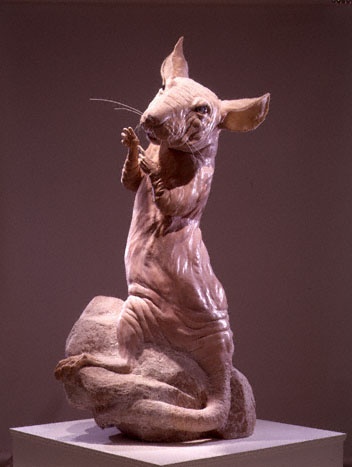Mice and Men
Bryan Crockett
Ecce Homo, 2000

marble and epoxy, 30 x 40 x 70 in.
Transgenics is the practice of transplanting genes from one species to another, thus creating genetic hybrids that can develop characteristics of both species. Consider what is happening with genetics. For instance, the oncomouse is the first patented transgenic lab mouse, engineered to have a human immune system for the purpose of oncology research. In this way, the practice of genetics can be understood as an analogy to the worlds of allegory and mythology. Like the Satyr or Minotaur, the oncomouse is the literalization of a clichÈ man/mouse. That is why I have chosen to reinterpret the ultimate figure of salvation, Christ, through the ultimate actor of contemporary science, the oncomouse. This sculpture is intended to be a monument to the test object of modern science, human kindís symbolic and literal stand-in personified. This human-scale, fleshy mouse, sculpted with the pathos of classical sculpture, stands in a gesture reminiscent of Christ revealing his wounds. Almost six feet tall he is nude (as is the oncomouse) and his flesh is a very convincing pale skin tone. Upon further inspection, however, one realizes the mouse/man is actually sculpted in flesh-colored marble. The lifelike sculpture and skin texture makes the sculpture oscillate between a living creature and a strong likeness, evoking the Pygmalion myth.

Back in 1997, a rather bizarre photograph suddenly became very famous. It showed a totally hairless mouse, with what appeared to be a human ear growing out of its back. That photograph prompted a wave of protest against genetic engineering, which continues today.